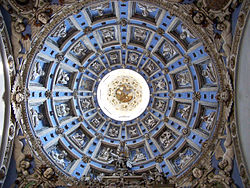Stefaniia Demchuk, Taras Shevchenko National University of Kyiv/Masaryk University
Due to its extraordinary appearance and interior ‘smothered with decoration’ as Jan Bialostocki put it, the Boim chapel (1597 – 1615) in Lviv has been rightfully a subject of numerous studies. It had been claimed that the iconography of the altar looks back to the Netherlandish engravings of the late sixteenth century, in particular to the ‘Thesaurus sacrarum […]’ and Piscator’s Bible as Waldemar Deluga pointed out. But neither Deluga nor other scholars who studied the chapel did not try to explain this unique choice of the Passover for the Passion cycle.
I shall argue that the Passover scene, which occupies a place under Christ in the Gethsemane normally reserved for the Last supper, brings us back to the Reformation-fused discussions of the meaning of the Last supper, its similarity with Passover and the moment of Transubstantiation that took place in Germany in the Netherlands but spilt through the borders through the texts and images. Jan Pfister’s take on it probably inspired not only by the Thesaurus but also by Huybrecht Beuckelaer’s Passover testifies both to his interconnectedness with German and Netherlandish art and to the religious entanglement of early modern Lviv and the possible religious ambiguity of the Boim family.
Stefaniia Demchuk, PhD, is an assistant professor of art history at Taras Shevchenko National University of Kyiv and a Research Fellow at Masaryk University (Brno). She is currently working on her postdoctoral project devoted to the culture of memory and art of early modern Netherlands. The project looks in particular at artistic exchanges between the Netherlands and East-Central Europe.
